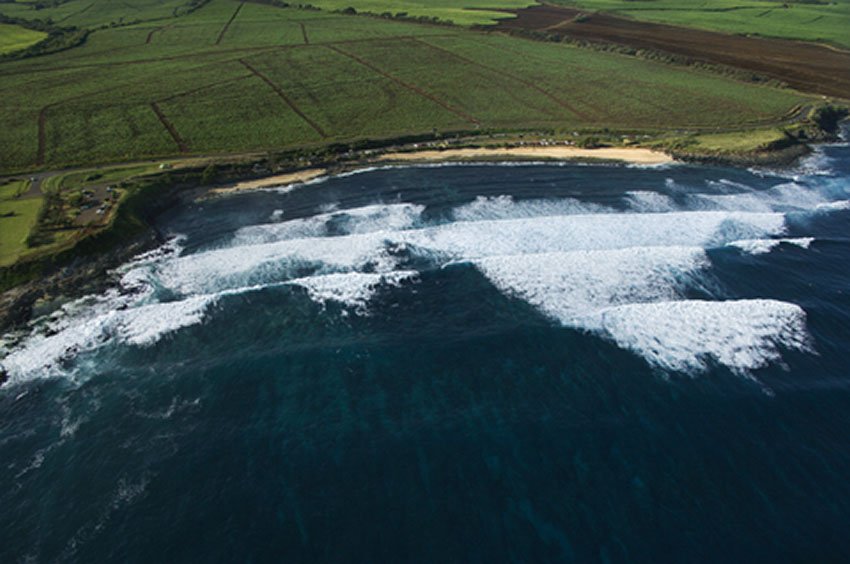Jaws (Peahi)

Jaws (Pe'ahi) is Maui's legendary big-wave surf break on the island's north shore, renowned for producing waves that can reach up to 70 feet high. Located near the town of Paia, this iconic surf spot draws elite surfers and tow-in teams each winter to challenge its fast, barreling waves. Known for its intensity, Jaws is best observed from a cliffside vantage point during large swells. It's a cultural and athletic landmark where ocean power meets human daring.
Jaws (Peahi), Maui
Amongst rolling fields of sugarcane surfers migrate to the north shore of Maui for what is arguably the best surf in the world. It’s true that there are a few other great surf spots on earth that boast similar wave heights, but Jaws is known for its excellent wave forming quality. The reef here is shaped in a way that magnifies the incoming waves and produces clean right and left-directional waves with huge barreling (hollow, air-tube interiors) sections. The waves at Jaws can reach heights of up to 70 ft (21 m)!
The swells travel across the Pacific from an Alaskan Aleutian island chain in the northern part of the Bering Sea. Unblocked by landfall, the swells arrive at Jaws with an unmerciful bite. These enormous waves can reach speeds of up to 30 miles per hour (48 km/h).
Peahi means “beckon” in the Hawaiian language and is the Hawaiian name for this surf break, but it is more commonly known as Jaws and got that name due to the size and ferocity of the swells. Surfers attempt to conquer Jaws just as the citizens of Amity Island attempted to defeat the threatening shark in Jaws, a 1975 film directed by Stephen Spielberg.
The waves at Jaws are mostly surfed in the winter months (November to March) and break just a few times a year. Monumental breaks occur once every couple of years, but when the time comes, the beach is as flooded with people as the ocean itself. There are often times cameras pointing at surfers from both the beach and from helicopters above.
Historically, Jaws is known for the introduction of “tow-in” surfing, a surfing technique in which the surfer is towed in by a rope connected to either a helicopter or a speedboat (or Jet Ski) in order to place the surfer in the right location of the waves. Due to the size and speed of the waves here, it is impossible for a surfer to traditionally enter the waves by paddling from shore.
Laird Hamilton and Dave Kalama, two famous surfers of the area, are known for their innovations to this new technique of surfing. Some find tow-in surfing offensive as it takes away from the natural vibe that surfing is all about. However, if one is to conquer the rage of Jaws, tow-in surfing is the safest and most proficient way to go about the feat.
With an increase of spectators and surfers, surfing here is becoming more and more dangerous. Too many people in the water can create a hazardous environment for the surfers and an increase in injuries.
On an ordinary day when the water is calm, there isn’t much to see here. But when the surf is way up, scores of people rush here to get a good vantage point on the cliff overlooking the bay. The space is tight here, so some people in the past drove over the nearby pineapple fields to park their car, which angered the landowners. In the past, many of the paths to Peahi Bluff were purposefully blocked with derelict cars set on fire by those angered by the increase in the overpopulated beach line.
Professional surfers also became angered by the masses of speculators and inexperienced surfers that were attempting to surf here. It is implied that surfers are only welcome at Jaws if they have an invitation from a veteran tow-in surfer who is locally experienced.
Key Features of Jaws (Pe'ahi)
- World-famous surf break: Recognized globally for some of the largest and most powerful waves surfed anywhere.
- Tow-in surfing birthplace: Introduced here by surfers like Laird Hamilton to conquer waves too big to paddle into.
- Seasonal surf action: Massive waves form between November and March during ideal winter swells.
- Spectator hotspot: During major swells, crowds gather on the cliffside to watch professional surfers ride giants.
- Remote, off-road access: Reached via a rugged dirt road beyond Hahana Road, often requiring 4WD and local guidance.




Frequently Asked Questions
When is the best time to see Jaws in action?
The big waves usually appear between November and March, with the most epic swells occurring just a few times a season.
Where is Jaws located?
Jaws is located about 3 miles east of Paia. Access is via Hahana Road between mile markers 13 and 14 on Hana Highway, followed by a dirt road.
Can beginners surf at Jaws?
No. Jaws is for expert and professional surfers only. It is extremely dangerous due to wave size, power, and speed.
How do I get to the Jaws viewpoint?
You'll need to park near the end of the paved road and walk or drive a 4WD vehicle down a dirt trail to a bluff overlooking the surf break.















